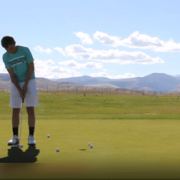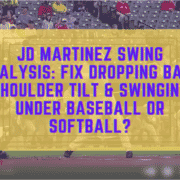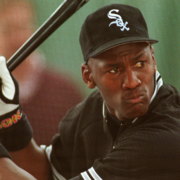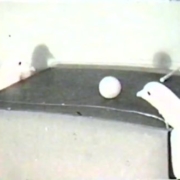Game Like Batting Practice: Fun Hitting Stations To STOP Struggling At Plate For Baseball & Softball
Discover game like batting practice. Learn about fun hitting stations to STOP your son or daughter struggling at the plate for baseball and softball.
Train Ugly: Transition To Game Swings In Less Time With Random Practice
My friend and colleague, Lee Comeaux, Shared this video with me, and I just had to share it with you. CLICK HERE for a post I did awhile back, showcasing 8 science of successful learning principles that are validated by empirical research.
This video goes into one of the principles mentioned in that post, the art of variance…Or “training ugly” as Trevor Ragan calls it in the video (CLICK HERE for his website).
Below are my bullet point notes from the above video:
- 1:10 – performance is best because you do things that have higher levels of retention – does practice promote better retention?
- 2:00 – What is a skill? Just Technique? 1/3 of the equation
- 2:45 – Read, Plan, Do
- 6:00 – How to practice this…Block (or Massed) Practice
- 7:00 – Random Practice
- 8:00 – Studies showing the benefits of Block versus Random Practice
- 9:15 – Coach Tom Black explains WHY Block Practice is more attractive to coaches: ego and/or seeing immediate gains with it, answer the WHY – easier for coach to let go of Block Practice…find better ways to track progress (transfer and retention to games test)
- 11:15 – WHY do we see dramatic gains transferred to competition with random practice? When Block Practice, we’re eliminating Reading and Planning from the motor learning equation. Random is like the game! “You play volleyball, you don’t drill volleyball”.
- 14:25 – taking a Growth Mindset into practice…Random Practice is more challenging, will make more mistakes, will be uglier, better for us, prepares us better for game situations
TRAIN UGLY Coaches!!
PLEASE share below how you’ve used this OR will use this with your hitters and players…
THANKS in advance for your responses 😀
SCIENCE-BASED TRAINING:
Improve your hitting strategy dramatically by applying human movement principles.
Learn not only how and what to train but also the science behind the methods.
- Fix Your Child’s Fear of the Ball Fast: Proven Hitting Drills to Stop Flinching at Pitches—Trusted by Top Youth Baseball Coaches - July 12, 2025
- Fix Your Little Leaguer’s Hitting Slump Fast – Proven Confidence Drills & Mental Reset Tools (Used by Top Youth Baseball Coaches) - July 9, 2025
- Best Hitting Drills for 8-Year-Olds (2025): Fix Swing Flaws Fast with This MLB-Trusted Youth Baseball System—At-Home, Step-by-Step, and Built for Game-Day Confidence - July 5, 2025













Science is a wonderful way to approach how to become better at your sport or sports.
My takeaway is”the most important part in our sport is reading”.
Joey, Quick Question, that sort of relates, saw a hitting guy the other day that said he thought Baseball players take too many swings per day. How many reps do you think a hitter should take during a daily session of hitting instruction?
Ken, I agree with this hitting guy…less reps in the cages…the timing and amount of reps should be somewhat close to game swing reps. I’d say 50 swings tops in cages. Make each swing count.
As a HighSchool coach I’ve had a similar approach to coaching but I really like this approach,can you suggest a few ideas for baseball practice,it is really easy to fall into that block practice
Sure Coach, I know what you mean…having players shift between two distance plates for batting practice, say every 5 swings. Moving ball around on the tee, never swing at same pitch location twice in a row. I just started to the reverse strike-zone drill during B.P., where hitters work on hitting “balls” for two rounds of 5, then go back to hitting “strikes.” This really melts their brain. Put pieces of frog tape on the barrel about an inch or so apart and have hitters practice hitting each piece of tape, this is for barrel control…do random pitch B.P. rounds where hitters see CB, CU, SL, FB, KB, etc. without knowing what’s coming. Those are some examples…more to come. Let your imagination run wild with this principle.
Brilliant! Thanks….it’s funny… You say train UGLY… Like everything we do… It’s always if we KNOW what we are SEEING or FEELING… And now, thanks to Joey, when we see these neat perfect practices, meaning only neat practices… Well some might see them as neat and organized but now we know what to look for and NOW we see them as ******. ?
Thanks Joey!
~DM
Haha Djura! Yes, I think training “goofy” is a better analogy…because that’s the way random training feels 😉
Good stuff! Can you introduce some random baseball drills for a 14U travel team that trains indoors in the winter- mid-March?
Coach Paul, check out my response to Coach David Wilson 😀
I also do this “goofy” or variance training with teaching mechanics…for instance showing numbers v. not showing numbers…in a 5 swing round, I’ll have my hitters show their numbers on odd swings, and not showing numbers on even swings.
Thanks Joey, Would using a patch over one eye then the other be the same thing or do you think this might screw them up? I make all my kids take cuts from the opposite side to just loosen or keep them flexible on both sides of their body, but based on what you say and this article there may be more to it than just the flexibility advantage. Great Stuff!
Coach Ken, the path thing may work. I do like having hitters take more swings on their non-dominant side.
What’s your thought about when the player is learning a new movement. Does a little blocked practice make sense to isolate the “doing” part first without overloading the player?
JD, you can try it, I tend to use variance training (doing it “right” way and “wrong” way) even when working new movements. Again, it’s more frustrating for the hitter but they learn to feel it both ways, then we block it, but even then, the reps are only blocked for 5 swings. Less reps, more quality and intensity within those reps.